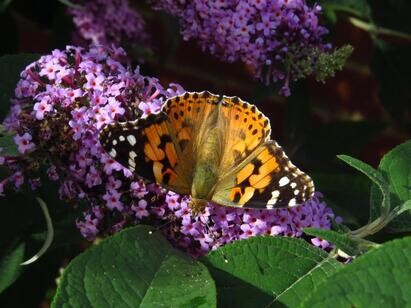Find out how to grow and care for caryopteris.

Ten top plants to bring wildlife into your garden
We love gardens. We love wildlife. And with good planning we can have both.
All plants are useful to something or other. But some are better than others. It’s not just a question of whether the plant is a British native or not: while native plants may be more use to more insects, to restrict your garden palette in that way is to lose the incredible, exciting range of gardening opportunities from around the world.
Just one ground rule: avoid anything in which the ‘naughty bits’ of the flowers (which produce pollen and nectar) have been bred into additional petals. Take Kerria japonica ‘Pleniflora’, or mop-head Hydrangea, or Viburnum opulus ‘Sterile’: they promise everything but deliver nothing – no nectar, no pollen, no seeds, no fruits, no place in the wildlife garden.
Plants that encourage wildlife whatever garden conditions you have
- Teasel Dipsacus fullonum: what’s not to like? Flowers that are avidly searched by bumble-bees, seeds that attract Goldfinches, old flower-heads to give visual interest in winter, and a plant that will gently self-seed around the place, continuing the natural banquet.

- Mexican Cone-flower Echinacea purpurea – long-lasting flowers from mid-summer, especially loved by hoverflies, some of the army of ‘forgotten pollinators’ in our gardens.

- Hesperis matronalis Dame’s Violet is a late spring-flowering relative of Honesty: both species are known to be used by Orange-tip butterflies to lay their eggs on. Looking after such flying jewels is important: we need to provide food for adults and larvae alike.

- Butterfly-bush, better known by its scientific name Buddleja, does as its name suggests – it feeds butterflies with its abundant nectar. Any of the species and forms seem to work, so you can choose the colour that suits you, from white to orange to mauve to purple.

Wildlife-attracting plants for dry conditions
- Eryngium species, of which there are many, often known as Sea-hollies, provide nectar and pollen for bees in particular throughout their protracted flowering seasons; they are also mostly very drought-tolerant, making them ideal for the garden with an eye to the future.

- And if you are lucky enough to have a sheltered spot, perhaps a south-facing wall, or be close to the sea to keep out the worst of the frost, try some of the impressive range of Giant Viper’s-buglosses from the Canaries and other Atlantic islands. Echium pininana is particularly impressive, four metres tall, a summer-long multistorey restaurant for bees, an autumn larder for Greenfinches.

Plants to attract wildlife in shady areas
- Hellebores Helleborus spp. are essential plants of a shady winter garden, for the promise of spring they bring, and for hungry queen bumblebees just emerged from hibernation.

- And for the other end of the summer, consider Ivy Hedera helix. It doesn’t strangle and kill trees; it does feed a myriad wasps, butterflies, moths, bees and hoverflies, which in turn are food for birds and other garden denizens.

Damp-loving plants that encourage wildlife
- Hemp-agrimonies Eupatorium spp. look great in a damp garden, their dense heads of flowers providing nectar to all the insects you could imagine…

- … whereas Bog Sage Salvia uliginosa, a touch of exotic South American blue, reserves its riches for the larger bees, those powerful enough to get into the heart of the flowers.

These suggestions are ideas of plants you could try but there are many, many more. Observing what’s attracting the butterflies, bees or whatever else interests you, and taking that as Nature’s recommendation is one of the best ways to be inspired - and we welcome you to do that here in Beth's gardens.
By our resident wildlife expert Dr Chris Gibson

COMMENTS